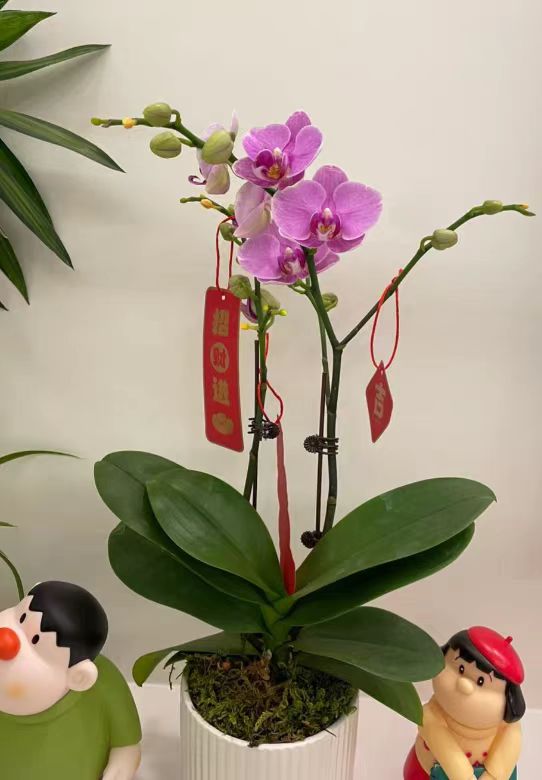For Phalaenopsis, when the flowers have withered, many people hesitate when faced with the seedlings after flowering, not knowing whether to continue to care for them or just abandon them. In fact, as long as you master the scientific planting methods, it is not difficult to take care of Phalaenopsis seedlings after the flowers have withered. They can regain their vitality and bloom beautifully again.
The difficulty of caring for Phalaenopsis seedlings after the flowers have withered actually depends on several factors. Firstly, after the flowering period, the seedlings after flowering have consumed a large amount of nutrients, so they need a certain period of recovery time after being brought home. During this period, if the care is improper, it is easy to cause problems such as empty roots, rotten roots, and shriveled leaves. Secondly, the quality of the seedlings after flowering in the market varies. Some may have been treated with hormones, resulting in deformed leaves; some have poor root conditions, and even the rotten roots are covered with soil. These problems increase the difficulty of care.
Planting steps for Phalaenopsis seedlings after the flowers have withered:
Trim the withered flowers in a timely manner: After the Phalaenopsis flowers have withered, trim the withered flowers in a timely manner. Use a clean and sharp pair of scissors to cut about 5-10 centimeters upwards from the base of the flower stem. Avoid leaving a long residual stem on the plant to prevent the residual stem from rotting and causing diseases and pests. If there are still unopened flower buds on the flower stem and the overall plant is in good condition, you can also keep the upper part of the flower stem, and there is a chance of a second blooming.
Replace the planting medium reasonably: During the flowering process of Phalaenopsis, a large amount of nutrients in the original planting medium have been consumed, and its air permeability and water permeability will also deteriorate, so the planting medium needs to be replaced. Phalaenopsis is an epiphytic orchid, and its roots require good air permeability. Commonly used planting media include moss, sphagnum moss, bark, etc. Taking sphagnum moss as an example, first soak the sphagnum moss in clean water to make it fully absorb water, and then take it out and squeeze out the excess water. Take the Phalaenopsis out of the original flower pot, gently clean the old planting medium from the roots, and be careful not to damage the roots. Lay a layer of planting medium at the bottom of the new flower pot, place the Phalaenopsis in it, fill the area around the roots with sphagnum moss, and gently compact it to ensure the stability of the plant.
Control the water precisely: After the flowers of Phalaenopsis have withered, its water demand decreases. When watering, follow the principle of "watering when the medium is dry and keeping it moist". To judge the dryness and wetness of the planting medium, you can insert your finger about 2-3 centimeters into the medium and water when it feels dry; or observe the color of the sphagnum moss and water when the sphagnum moss turns white. When watering, water thoroughly to allow the excess water to flow out from the bottom of the flower pot to avoid waterlogging, which may cause root rot. In winter, when the temperature is low and the growth of Phalaenopsis is slow, the frequency of watering can be appropriately reduced; in summer, when the temperature is high and the water evaporates quickly, the number of waterings can be appropriately increased, but over-wetting should still be avoided.
Supplement fertilizers scientifically: After the flowers have withered, Phalaenopsis needs to be supplemented with nutrients to promote the growth of new roots and shoots. Within 1-2 weeks after trimming the withered flowers, the plant is in the recovery stage, so do not fertilize temporarily. After that, apply a thin liquid fertilizer every 1-2 weeks. Choose a compound fertilizer with a balanced ratio of nitrogen, phosphorus, and potassium, and dilute it according to the instructions to avoid burning the roots with concentrated fertilizer. When the plant starts to grow new shoots and leaves, the proportion of phosphorus and potassium fertilizers can be appropriately increased to promote flower bud differentiation and prepare for the next blooming.
Create a suitable environment: Phalaenopsis likes a warm, humid, and semi-shaded environment. The suitable growth temperature is 15-28°C. In winter, the temperature should not be lower than 10°C, otherwise it will suffer from freezing damage; when the temperature exceeds 30°C in summer, cooling measures should be taken, such as enhancing ventilation and providing appropriate shading. In terms of light, avoid direct sunlight, and you can place it in a location with bright diffused light indoors, such as near a window but not directly exposed to sunlight. The air humidity should be kept at 60%-80%. In dry seasons, you can increase the air humidity by spraying mist around the plant or placing a water basin, but be careful to avoid water droplets staying on the leaves for a long time, which may cause diseases.
As long as you take care of Phalaenopsis seedlings after the flowers have withered carefully according to the above methods, they can thrive and bloom again. Caring for flowers is not only a process of cultivating plants but also a journey of communicating with nature and reaping surprises and beauty.
Is it easy to take care of Phalaenopsis seedlings after the flowers have withered?

Share with
Tagged in :




Leave a Reply